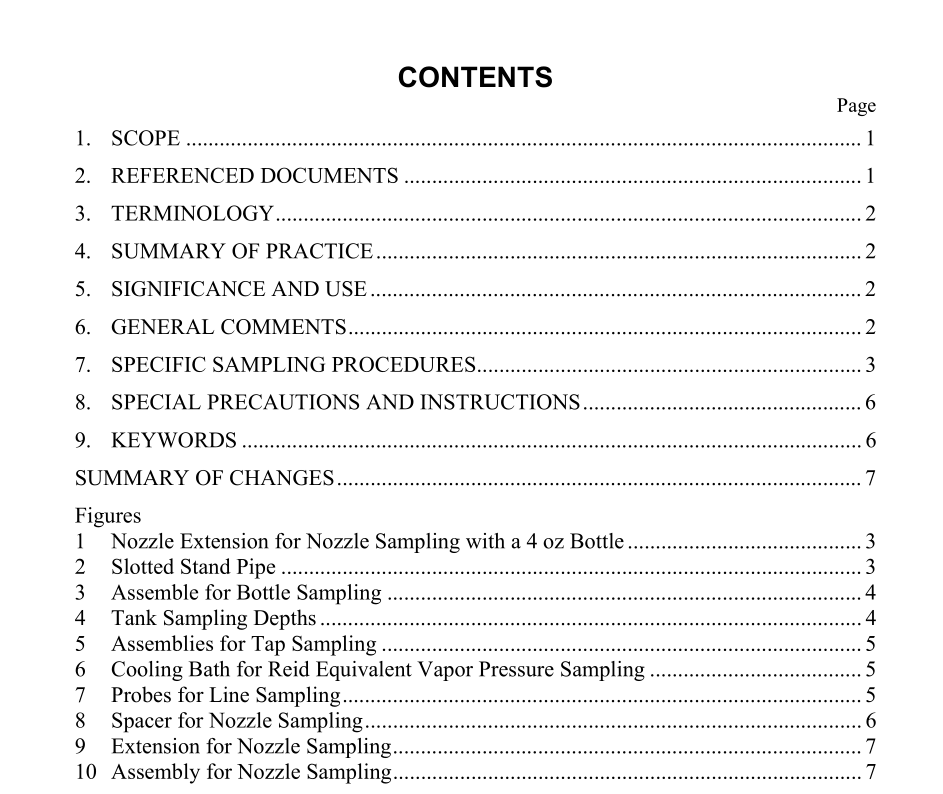API MPMS 8.4 pdf download

API MPMS 8.4 pdf download.Standard Practice for Sampling and Handling of Fuels for Volatility Measurement
1. Scope
1.1 This practice covers procedures and equipment for obtaining, mixing, and handling representative samples of volatile fuels for the purpose oftesting for compliance with the standards set forth for volatility related measurements appli- cable to light fuels. The applicable dry vapor pressure equiva- lent range of this practice is 13 to 105 kPa (2 to 16 psia). 1.2 This practice is applicable to the sampling, mixing, and handling of reformulated fuels including those containing oxygenates. 1.3 The values stated in SI units are to be regarded as the standard except in some cases where drawings may show inch-pound measurements which are customary for that equip- ment. 1.4 This standard does not purport to address all of the safety concerns, if any, associated with its use. It is the responsibility of the user of this standard to establish appro- priate safety and health practices and determine the applica- bility ofregulatory limitations prior to use.
3. Terminology
3.1 Definitions ofTerms Specific to This Standard: 3.1.1 bottom sample—a sample obtained from the material at the bottom of the tank, container, or line at its lowest point. 3.1.1.1 Discussion—In practice the term bottom sample has a variety of meanings. As a result, it is recommended that the exact sampling location (for example, 15 cm [6 in.] from the bottom) should be specified when using this term. 3.1.2 dead legs—sections of pipe that, by design, do not allow for the flow of material through them. 3.1.2.1 Discussion—Dead legs are not suitable for obtaining representative samples. 3.1.3 relief lines—sections of pipe that lead to a pressure/ vacuum relief valve. 3.1.3.1 Discussion—Relief lines are not suitable for obtain- ing representative samples. 3.1.4 stand pipes—vertical sections of pipe or tubing ex- tending from the gaging platform to near the bottom of tanks that are equipped with external or internal floating roofs. Stand pipes also may be found on ships and barges. 3.1.4.1 Discussion—Stand pipes which are not slotted or perforated will not yield representative samples. Further infor- mation on proper stand pipe design is given in 6.4.3. 3.1.5 Other sample definitions are given in Practice D 4057/ API MPMS Chapter 8.1.
4. Summary of Practice
4.1 It is necessary that the samples be representative of the fuel in question. The basic principle of each sampling proce- dure involves obtaining a sample in such a manner and from such locations in the tank or other container that the sample will be representative of the fuel. A summary of the sampling procedures and their application is presented in Table 1. Each procedure is suitable for sampling a material under definite storage, transportation, or container conditions. The precau- tions required to ensure the representative character of the samples are numerous and depend upon the tank, carrier, container, or line from which the sample is being obtained, the type and cleanliness of the sample container, and the sampling procedure that is to be used.
6. General Comments
6.1 Sample Containers: 6.1.1 Sample containers are clear or brown glass bottles, fluorinated high-density polyethylene bottles, or metal cans. The clear glass bottle is advantageous because it is easily examined visually for cleanliness, and also makes visual inspection of the sample for free water or solid impurities possible. The brown glass bottle affords some protection from light. The only cans acceptable are those with the seams soldered on the exterior surface. 6.1.2 Cork stoppers, or screw caps of plastic or metal, are used for glass bottles; screw caps with inserted seals only are used for cans to provide a vapor-tight closure seal. Corks must be of good quality, clean, and free from holes and loose bits of cork. Never use rubber stoppers. Contact ofthe sample with the cork can be prevented by wrapping tin or aluminum foil around the cork before forcing it into the bottle. Screw caps must be protected by a cork disk faced with tin or aluminum foil, an inverted cone polyseal or other material that will not affect petroleum or petroleum products. The fluorinated bottles are supplied with polypropylene screw caps. 6.1.3 Sample size is dictated by the test method to be used. One litre (32 oz) bottles or cans are generally used for manual vapor pressure testing. Some vapor pressure methods may allow a smaller sample size to be taken, such as in a 125 mL (4 oz) bottle. See Fig. 1. 6.1.4 All sample containers must be absolutely clean and free of foreign matter. Before reusing a container, wash it with strong soap solution, rinse it thoroughly with tap water, and finally with distilled water. Dry completely and stopper, or cap, the container immediately.









